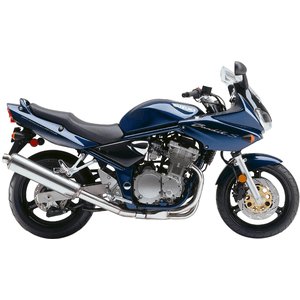Suzuki GSF 600 S Bandit [2000 – 2004]: The Unapologetic All-Rounder Revisited
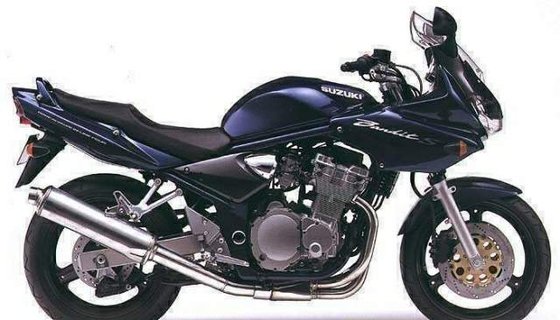
Introduction
The Suzuki GSF 600 S Bandit isn’t just a motorcycle—it’s a philosophy. Born from Suzuki’s knack for repurposing proven engineering into affordable, versatile machines, the 2000–2004 Bandit S iteration represents a sweet spot in the model’s evolution. With its frame-mounted half-fairing, rugged inline-four engine, and unpretentious design, this generation of the Bandit carved out a loyal following among riders who valued practicality without sacrificing the thrill of a sporty ride. Having spent time with a well-maintained 2003 example, I can confirm: this bike still holds up as a jack-of-all-trades that refuses to fade into obscurity.
Riding Experience: Where the Bandit Shines
Engine and Power Delivery
At the heart of the Bandit S lies its air/oil-cooled, 599cc inline-four engine—a derivative of Suzuki’s venerable GSX-R lineage but retuned for accessibility. The numbers (78 HP @ 10,500 RPM and 54 Nm of torque @ 9,500 RPM) might seem modest compared to modern standards, but the reality is a powerband that prioritizes usability over peak performance.
Twist the throttle, and the Bandit responds with a linear surge rather than a violent lurch. The mid-range is where this engine thrives, pulling strongly from 4,000 RPM all the way to its 11,500 RPM redline. While it lacks the top-end scream of its fully faired siblings, the Bandit’s power delivery is perfectly suited for real-world riding—overtaking on highways or carving through backroads feels effortless. The 6-speed gearbox is slick, though the clutch can feel heavy in stop-and-go traffic.
Handling and Comfort
Suzuki’s tubular steel frame and 41mm telescopic forks strike a balance between agility and stability. At 208 kg (458 lbs) dry, the Bandit isn’t a featherweight, but its weight distribution masks the heft. The 800 mm (31.5-inch) seat height accommodates shorter riders, while the upright riding position ensures all-day comfort.
The half-fairing, introduced in the 2000 update, deserves praise. Unlike earlier models with their boxy headlights, the twin-projector fairing reduces wind buffeting significantly at speeds up to 130 km/h (80 mph). It’s no Gold Wing, but for weekend tours or commuting, it’s a game-changer.
Braking performance is adequate, if not exceptional. The dual 290mm front discs with twin-piston calipers provide decent bite, though modern riders might crave more initial feedback. The rear 240mm disc does its job without drama.
Fuel Efficiency and Range
With an average consumption of 5.3 L/100 km (44.5 US mpg), the Bandit’s 20L (5.3-gallon) tank delivers a realistic range of 350–400 km (217–250 miles). That’s enough for spirited day rides without constant fuel stops.
Design and Features: Function Over Flair
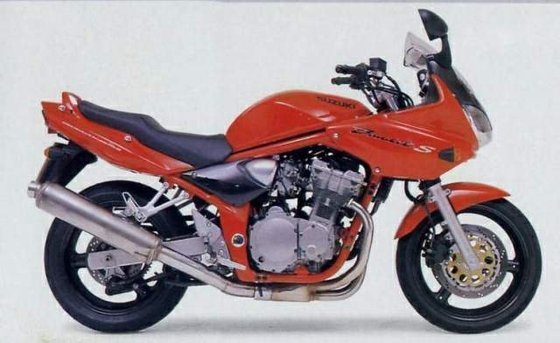
The 2000–2004 Bandit S trades flashiness for timeless simplicity. The twin-projector headlights and angular fairing give it a purposeful look, while the minimalist cockpit features an analog tachometer and speedometer—no frills, no distractions. Color options were limited to bold red and blue schemes, both aging gracefully compared to today’s gradient finishes.
Build quality is typical of early-2000s Suzukis: durable but not luxurious. The paint holds up well, though some owners report fading on sun-exposed panels. The seat foam strikes a balance between firm support and plushness, avoiding the “wooden plank” feel of some competitors.
Competition: How the Bandit Stacks Up
In the early 2000s, the middleweight naked/faired segment was fiercely competitive. Here’s how the Bandit S fared against its rivals:
Yamaha FZS600 Fazer
The Fazer’s liquid-cooled engine offered sharper throttle response and a slight power advantage (87 HP vs. 78 HP). However, the Bandit countered with a smoother power delivery and superior wind protection. The Fazer felt more sporty; the Bandit, more versatile.
Honda Hornet 600
Honda’s Hornet prioritized agility with its stripped-down design and rev-happy engine. While the Hornet was lighter and nimbler in city traffic, the Bandit’s fairing and torquier engine made it the better choice for riders covering longer distances.
Kawasaki ZR-7S
Kawasaki’s offering shared the Bandit’s retro-modern ethos but lagged in suspension adjustability. The ZR-7S’s carbureted engine was similarly bulletproof, though its styling polarized riders compared to the Bandit’s cleaner lines.
Verdict: The Bandit S wasn’t the fastest or the flashiest, but its blend of comfort, reliability, and ease of maintenance gave it an edge for riders seeking a “do-it-all” machine.
Maintenance: Keeping the Bandit Alive
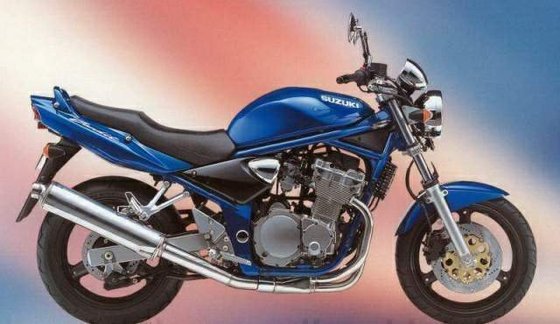
The GSF 600 S Bandit’s reputation for reliability is well-earned, but neglect will catch up with any 20-year-old bike. Here’s what owners should prioritize:
Valve Adjustments
The DOHC engine requires valve clearance checks every 6,000 km (3,700 miles). Intake valves should be 0.10–0.15 mm (0.004–0.006 in), exhaust valves 0.18–0.23 mm (0.007–0.009 in). Ignoring this can lead to costly top-end repairs.
Carburetor Tuning
The Keihin CVR32 carburetors are reliable but sensitive to ethanol-blended fuels. Clean them annually and adjust the air screws to 1.75 turns out. A carb sync tool is a wise investment for smoothing out idle hiccups.
Chain and Sprockets
The 112-link chain and 15/47 sprocket combo wears quickly if not maintained. Clean and lube the chain every 500 km (310 miles), and replace the set every 25,000 km (15,500 miles). Consider upgrading to an X-ring chain for longevity.
Oil Changes
Use SAE 10W-40 oil (3.5L with filter changes) every 4,000 km (2,500 miles). The air/oil-cooled engine runs hotter than liquid-cooled units, so avoid cheap mineral oils.
Brake System
Flush the DOT 4 brake fluid every two years. Upgrade to sintered pads for improved bite, especially if riding two-up.
Tires
Stick to the factory-recommended pressures:
- Front: 2.25 bar (33 psi)
- Rear: 2.5 bar (36 psi)
Modern radial tires like the Michelin Road 6 or Bridgestone Battlax BT-46 vastly improve grip over the original bias-ply options.
Conclusion: A Legacy of Practical Performance
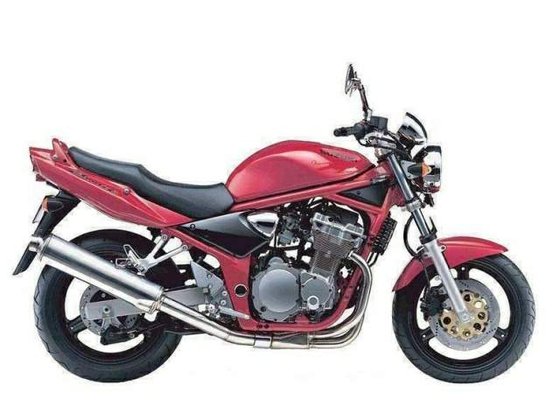
The 2000–2004 Suzuki GSF 600 S Bandit isn’t about chasing specsheets or turning heads at cafés. It’s about the joy of a machine that adapts to your needs—whether that’s a daily commute, a weekend twisty-road blast, or a cross-country tour. Its air-cooled engine might lack the polish of modern counterparts, but it compensates with character and durability.
For riders today, the Bandit S represents an affordable entry into classic Suzuki ownership. With basic maintenance and a few tasteful upgrades (better tires, upgraded suspension springs), it remains a compelling alternative to today’s tech-laden—but often soulless—middleweights.
At MOTOPARTS.store, we’re committed to keeping these legends on the road. From NGK CR9EK spark plugs to premium chains and sprockets, we’ve got everything to ensure your Bandit lives up to its name—a trusty companion that’s always ready for the next adventure.
Specifications sheet
| Engine | |
|---|---|
| Stroke: | Four-stroke |
| Ignition: | Digital Transistorized |
| Max power: | 57 kW | 76.0 hp |
| Max torque: | 54 Nm |
| Fuel system: | 4 x Keihin CVR32 carburetors |
| Max power @: | 10500 rpm |
| Displacement: | 599 ccm |
| Max torque @: | 9500 rpm |
| Configuration: | Inline |
| Cooling system: | Air/oil cooled |
| Compression ratio: | 11.3:1 |
| Number of cylinders: | 4 |
| Valves per cylinder: | 4 |
| Dimensions | |
|---|---|
| Wheelbase: | 1430 mm (56.3 in) |
| Dry weight: | 196 |
| Wet weight: | 218 |
| Seat height: | 800 mm (31.5 in) |
| Overall width: | 770 mm (30.3 in) |
| Overall height: | 1220 mm (48.0 in) |
| Overall length: | 2060 mm (81.1 in) |
| Ground clearance: | 130 mm (5.1 in) |
| Fuel tank capacity: | 20 L (5.3 US gal) |
| Drivetrain | |
|---|---|
| Final drive: | chain |
| Chain length: | 112 |
| Transmission: | 6-speed |
| Rear sprocket: | 47 |
| Front sprocket: | 15 |
| Maintenance | |
|---|---|
| Engine oil: | 10W40 |
| Idle speed: | 1200 ± 100 rpm |
| Brake fluid: | DOT 4 |
| Spark plugs: | NGK CR9EK |
| Spark plug gap: | 0.7 |
| Forks oil capacity: | 1.016 |
| Rear tire pressure: | 2.5 bar (36 psi) |
| Engine oil capacity: | 3.5 |
| Front tire pressure: | 2.25 bar (33 psi) |
| Engine oil change interval: | Every 5000 km or 2 years |
| Valve clearance (intake, cold): | 0.10–0.15 mm |
| Valve clearance check interval: | 24,000 km / 15,000 mi |
| Valve clearance (exhaust, cold): | 0.18–0.23 mm |
| Chassis and Suspension | |
|---|---|
| Frame: | Tubular steel double cradle |
| Rear tire: | 160/60-17 |
| Front tire: | 120/70-17 |
| Rear brakes: | Single 240 mm disc, 1-piston caliper |
| Front brakes: | 2 x 290 mm discs, 2-piston calipers |
| Rear suspension: | Monoshock, 4-way adjustable rebound damping, 7-way adjustable preload |
| Front suspension: | 41mm telescopic fork, oil damped |



